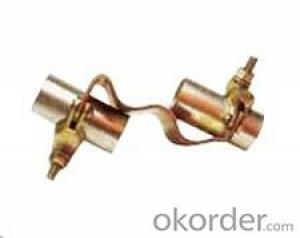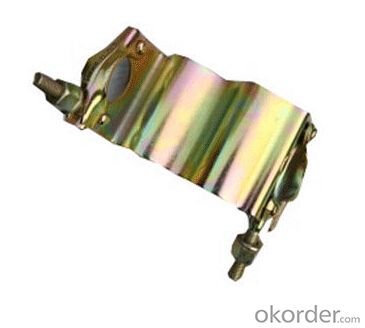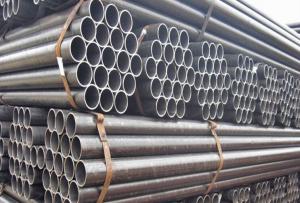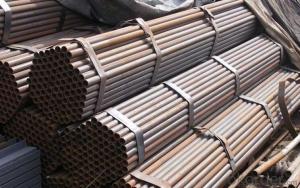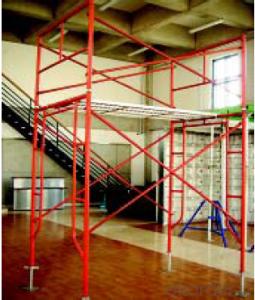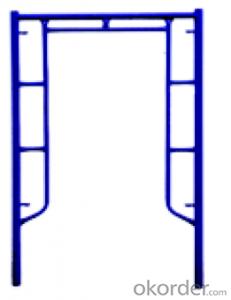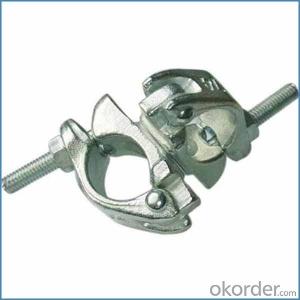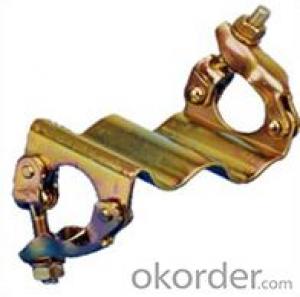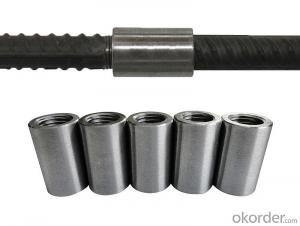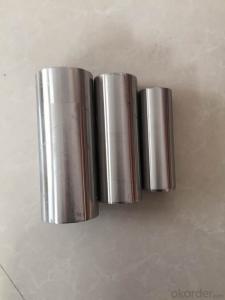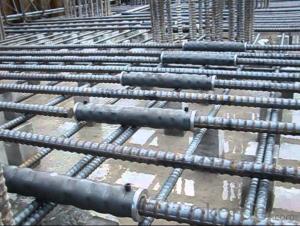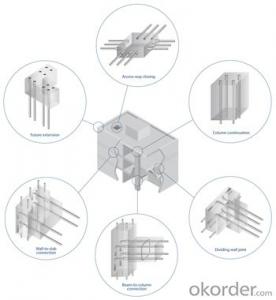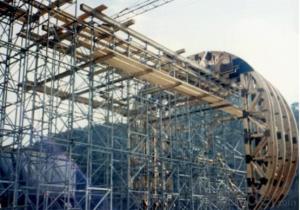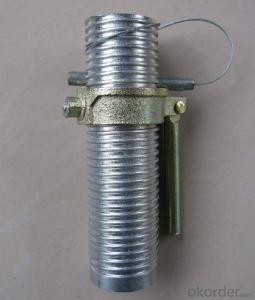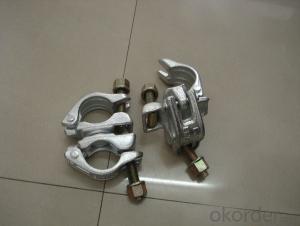Scalffolding Steel Tube Type Roofing Coupler
- Loading Port:
- China Main Port
- Payment Terms:
- TT OR LC
- Min Order Qty:
- -
- Supply Capability:
- -
OKorder Service Pledge
OKorder Financial Service
You Might Also Like
Quick Details
| Place of Origin: | Model Number: | ||||
| Type: | Material: | Size: | |||
| Surface Treatment: | Standard: | Weight: |
Packaging & Delivery
| Packaging Detail: | bags then on steel pallets or as your request. |
| Delivery Detail: | according to the order quantity |
Specifications
Roofing Coupler
1. BS1139/EN74 -1.
2. Clear marking.
3. Perfect surface.
4. Timely delivery.
1. Description of Roofing Coupler
Material | Q235/Q345/etc |
Dimensions | 48.3*48.3 or as your demands |
Surface | Hot-dip galvanization/ electro galvanization /painted /or as your request |
Standard | EN74,BS1139, |
Fastener Grade | class8.8 |
Weight | 1.2kg/ as your requirement |
Feature | 1.Good bearing capacity 2.Durable & stable |
Note | OEM service is available |
MOQ | 1000pieces |
Package | woven bags with steel pallets, or as your request |
Payment Terms | TT, L/C, or as our agreement. |
Delivery Time | According to order quantity. |
- Q: Can steel tube couplers be used for temporary or permanent scaffolding installations?
- Both temporary and permanent scaffolding installations can utilize steel tube couplers. These couplers are designed to securely connect scaffolding tubes, creating stable and dependable structures. Made from high-quality steel, they offer exceptional strength and durability. Temporary scaffolding installations often rely on steel tube couplers due to their simple assembly and disassembly. They can be swiftly and securely attached to scaffolding tubes, enabling the construction of temporary platforms, walkways, and support structures. When the temporary scaffolding is no longer needed, the couplers can be easily removed and reused for future projects. Similarly, steel tube couplers are suitable for permanent scaffolding installations. They establish a robust and long-lasting connection between scaffolding tubes, ensuring the stability and safety of the structure. Permanent scaffolding installations, commonly found in construction sites or industrial facilities, demand reliable and durable connections, making steel tube couplers an ideal choice. It is imperative to note that when utilizing steel tube couplers for scaffolding installations, proper installation techniques and adherence to safety regulations must always be followed. Regular inspections and maintenance are also necessary to ensure the integrity and reliability of the scaffolding structure, regardless of its temporary or permanent nature.
- Q: How do steel tube couplers compare to other scaffolding connectors in terms of cost?
- Compared to other scaffolding connectors, steel tube couplers are generally more cost-effective. This is mainly because of their straightforward design and construction, which makes manufacturing them easier and less expensive. Moreover, steel tube couplers can be reused and easily taken apart and put back together, reducing the necessity for frequent replacement. In contrast, clamp-type or wedge-type connectors, for example, may be more intricate and need extra components, resulting in higher expenses. Ultimately, the cost-effectiveness of steel tube couplers makes them a favored option for scaffolding systems, offering an affordable solution for construction projects.
- Q: What are the specific safety features of steel tube couplers?
- Steel tube couplers offer a reliable and secure option for joining steel tubes, thanks to their specific safety features. To begin with, these couplers are designed to ensure a strong and stable connection between two steel tubes. They possess a high load capacity, enabling them to withstand heavy loads and provide structural integrity. This effectively prevents any potential failure or collapse of the structure. Moreover, steel tube couplers are typically made from high-quality steel, enhancing their durability and strength. They are often treated with corrosion-resistant coatings, such as galvanized or epoxy coatings, to shield them from rust and other environmental factors. This guarantees that the couplers maintain their structural integrity over time, even in harsh conditions. Another crucial safety feature of steel tube couplers is their ease of installation. They can be quickly and easily assembled with minimal tools or specialized equipment. This reduces the risk of accidents or errors during installation, ensuring a safe and reliable connection. Furthermore, steel tube couplers are designed to provide a secure connection that prevents any movement or rotation between the joined tubes. This minimizes the risk of disconnection or misalignment, which could compromise the stability and safety of the structure. Some couplers even have extra features, like locking mechanisms or set screws, to further enhance the secure connection. In conclusion, the specific safety features of steel tube couplers, which include their load capacity, durability, corrosion resistance, ease of installation, and secure connection, make them a trusted choice for various construction applications.
- Q: How do steel tube couplers compare to other types of scaffolding connectors?
- Steel tube couplers are generally considered to be stronger and more durable compared to other types of scaffolding connectors. They provide a secure and reliable connection between scaffolding tubes, ensuring stability and safety. Additionally, steel tube couplers are versatile and can be used in various scaffolding configurations, making them a preferred choice for many construction projects.
- Q: What are the common sizes and dimensions of steel tube couplers?
- The common sizes and dimensions of steel tube couplers vary depending on the specific application and industry requirements. However, there are some standard sizes that are commonly used. Steel tube couplers usually come in various diameters and lengths to accommodate different tubing sizes. For example, in the construction industry, where steel tube couplers are commonly used for scaffolding and structural applications, the most common sizes range from 48.3mm (1.9 inches) to 60.3mm (2.375 inches) in outer diameter. The lengths of these couplers can vary from about 80mm (3 inches) to 100mm (4 inches) or more. In industrial applications, such as piping systems, the sizes of steel tube couplers can be much larger. These couplers can have outer diameters ranging from a few inches to several feet, with corresponding lengths to fit the size and weight requirements of the pipes being connected. It is important to note that the dimensions and sizes of steel tube couplers can also depend on the specific standards and regulations followed in different regions or industries. Therefore, it is always advisable to consult the relevant codes and specifications to ensure the correct selection of couplers for a particular application.
- Q: Can steel tube couplers be used in scaffolding projects with heavy loads?
- Scaffolding projects with heavy loads can indeed incorporate steel tube couplers. These couplers are specifically engineered to establish a sturdy and reliable connection between scaffolding tubes, thereby ensuring stability and safety. They are frequently utilized in construction endeavors involving substantial loads, such as tall buildings or industrial facilities. Made from top-notch steel, these couplers are designed to endure the weight and pressure exerted by heavy loads. Nevertheless, it is imperative to guarantee accurate installation of the couplers and to ensure that the scaffolding structure is adequately designed and supported to accommodate the anticipated load. Consistently inspecting and maintaining the scaffolding system is also of utmost importance in order to uphold its structural integrity and safety.
- Q: How do steel tube couplers contribute to the versatility of a scaffolding system?
- Steel tube couplers contribute to the versatility of a scaffolding system by providing a secure and flexible connection between steel tubes. These couplers allow for easy assembly and disassembly of scaffolding components, enabling the system to be adjusted and rearranged quickly according to the specific needs of the construction project. This versatility enhances efficiency and safety on the work site, as it allows for the scaffolding to be easily adapted to different heights, angles, and configurations.
- Q: How long do steel tube couplers typically last in scaffolding applications?
- Steel tube couplers typically last for several years in scaffolding applications, with an average lifespan of around 10 to 15 years. However, this can vary depending on various factors such as the quality of the couplers, the frequency and intensity of use, and the maintenance and care given to them.
- Q: Are there any specific regulations or standards for the use of steel tube couplers in scaffolding?
- Steel tube couplers in scaffolding have specific regulations and standards. Occupational health and safety authorities establish these regulations and standards in many countries to guarantee worker and public safety. One extensively recognized standard for scaffolding is the European Standard EN 74. This standard covers the general requirements for steel tube couplers, fittings, and accessories used in scaffolding and related temporary structures. It outlines the dimensions, materials, load-bearing capacities of the couplers, as well as the testing and certification requirements. Furthermore, national regulations may exist, which provide additional specifications for the use of steel tube couplers in scaffolding. In the United States, for instance, the Occupational Safety and Health Administration (OSHA) offers comprehensive guidelines on scaffold construction, including the use of couplers. OSHA mandates that all scaffold couplers used in construction meet or exceed manufacturer's specifications and undergo inspection before each use. Scaffolding contractors and workers must comply with these regulations and standards to ensure the scaffold structure's safety and stability. Non-compliance can lead to accidents, injuries, or even fatalities. Therefore, it is advisable to consult relevant local regulations and standards and seek guidance from industry experts or professional organizations to ensure adherence to the specific requirements for the use of steel tube couplers in scaffolding.
- Q: Are there any specific guidelines for the safe use of steel tube couplers in scaffolding near areas with high wind speeds or gusts?
- Yes, there are specific guidelines for the safe use of steel tube couplers in scaffolding near areas with high wind speeds or gusts. Here are some key points to consider: 1. Structural Stability: It is crucial to ensure that the scaffolding structure is capable of withstanding the anticipated wind loads. This includes using appropriate steel tube couplers that meet the required strength and load-bearing capacity. 2. Manufacturer Recommendations: Follow the manufacturer's guidelines and instructions for the specific steel tube couplers being used. These guidelines often include information on load limits, installation procedures, and precautions for high-wind conditions. 3. Wind Load Calculation: Conduct a wind load calculation to determine the expected forces on the scaffolding. This calculation takes into account factors such as wind speed, gusts, and the surface area of the scaffolding system. Adhere to the specific wind load requirements of the relevant industry standards and local regulations. 4. Secure Connections: Ensure that all steel tube couplers are properly and securely connected to prevent any movement or dislodgement during high wind conditions. Regularly inspect the couplers for any signs of wear, damage, or loose connections, and address any issues immediately. 5. Bracing and Tying: Implement adequate bracing and tying techniques to enhance the stability of the scaffolding system. This may include diagonal bracing, tie-backs, and guy wires to counteract the wind forces and minimize the risk of scaffold collapse. 6. Monitor Weather Conditions: Continuously monitor the weather conditions, especially wind speeds, and be prepared to take necessary precautions or halt work if wind speeds exceed safe limits. Use weather monitoring tools and forecasts to stay informed about changing conditions. 7. Regular Inspections: Conduct regular inspections of the scaffolding system, including the steel tube couplers, to identify any potential hazards or weaknesses. Carry out these inspections before and after extreme weather events to ensure the scaffolding remains safe and secure. Remember, the specific guidelines may vary depending on the region, industry standards, and local regulations. Therefore, it is essential to consult relevant authorities, engineers, or safety professionals to obtain comprehensive guidance tailored to your specific situation.
Send your message to us
Scalffolding Steel Tube Type Roofing Coupler
- Loading Port:
- China Main Port
- Payment Terms:
- TT OR LC
- Min Order Qty:
- -
- Supply Capability:
- -
OKorder Service Pledge
OKorder Financial Service
Similar products
Hot products
Hot Searches
